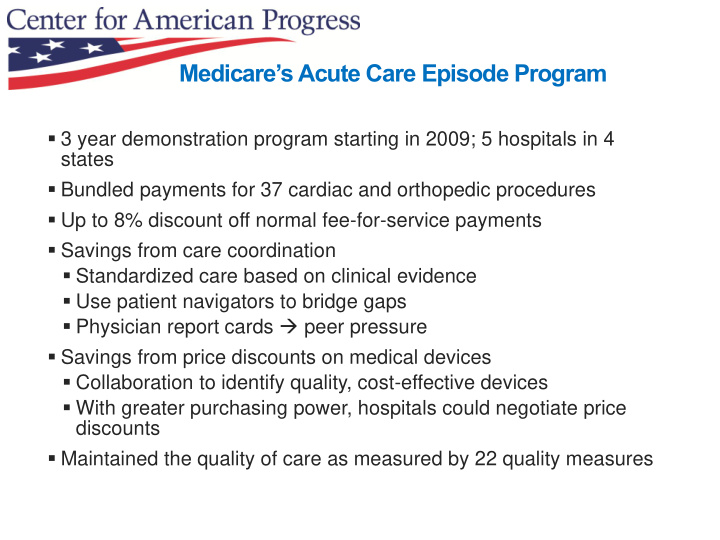



Medicare’s Acute Care Episode Program 3 year demonstration program starting in 2009; 5 hospitals in 4 states Bundled payments for 37 cardiac and orthopedic procedures Up to 8% discount off normal fee-for-service payments Savings from care coordination Standardized care based on clinical evidence Use patient navigators to bridge gaps Physician report cards peer pressure Savings from price discounts on medical devices Collaboration to identify quality, cost-effective devices With greater purchasing power, hospitals could negotiate price discounts Maintained the quality of care as measured by 22 quality measures
Using the ACA’s Key Cost Control Tool Goal: expand a bundled payment nationwide before the President leaves office Ensure the current health cost slowdown continues Demonstrate the potential of the Affordable Care Act Send a signal to health care providers The ACE Program meets the test for expansion Expansion could be effective for fiscal year 2015 Including post-acute care in bundling is important: over 70% of variation in Medicare costs is from variation in post-acute care
Bundled Payments vs. ACOs ACOs are voluntary, and thus can’t be expanded nationwide ACOs aren’t appropriate for many (rural) areas of the country Bundled payments are easier to implement, require less upfront investment ACOs take time to realize returns on investment Bundled payments yield immediate price savings
Beyond bundling for acute episodes: bundling for cancer Why cancer? High and rising disease burden; high and rising costs of care ($173 billion by 2020) IOM: current cancer care system is in crisis Widely varying treatment strategies and costs, despite existing care guidelines Drugs are a significant portion of costs Questions to be answered: Which cancers and stages? Bundle could vary based on specific diagnoses What to include in the bundle? Diagnostic tests, imaging, drug administration, management fee, labs, chemotherapy, radiation services, hospitalizations, surgery What length of time should the bundle cover? What measures should define the bundle? Outcomes, process, patient- reported CAP has organized a consortium of oncologists, patients, payers, and policy experts to answer these questions
Bundling need not be foreign In 2004, Germany adopted Diagnosis Related Groups Now Germany bundles all costs for inpatient episodes of care, including physician services No additional payment for re-admissions related to the bundle In 2008, Germany started bundling outpatient services Single fixed rate for all care in a quarter of the year Insurers offer contracts for “integrated care” – including post-acute care in the bundle Evidence of success Duplicative services (imaging) have declined Use of pricey technology (imaging) has declined More consensus on treatment pathways, less variation
Recommend
More recommend